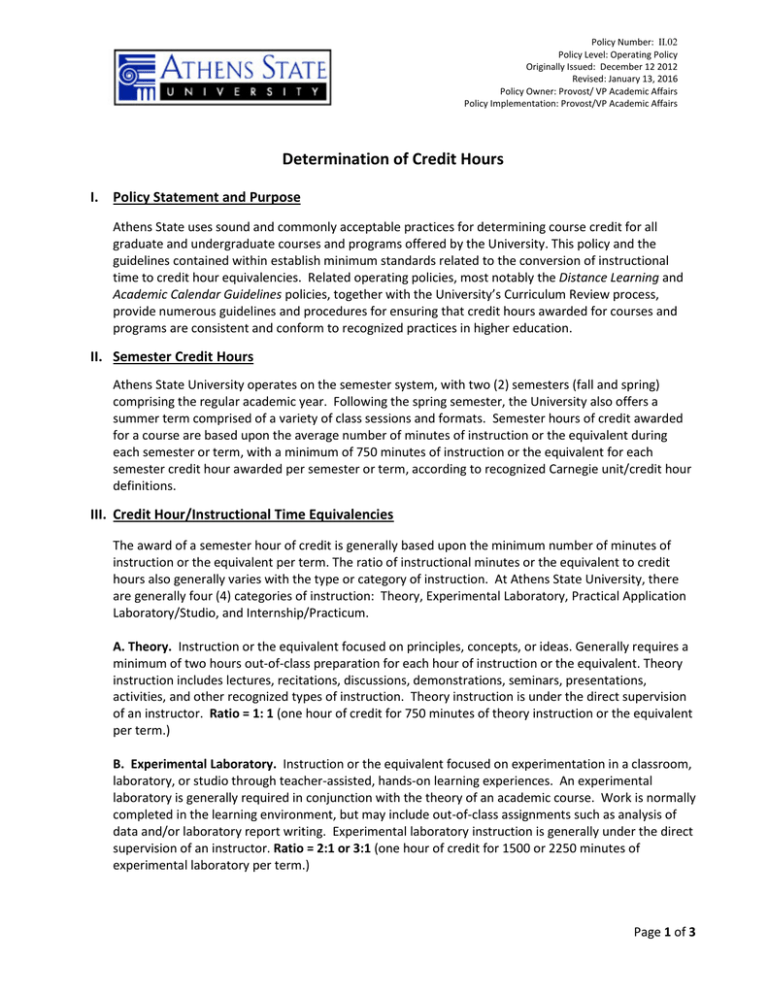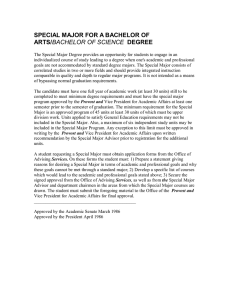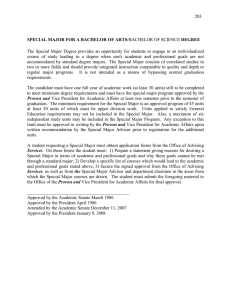Determination of Credit Hours
advertisement

Policy Number: II.02 Policy Level: Operating Policy Originally Issued: December 12 2012 Revised: January 13, 2016 Policy Owner: Provost/ VP Academic Affairs Policy Implementation: Provost/VP Academic Affairs Determination of Credit Hours I. Policy Statement and Purpose Athens State uses sound and commonly acceptable practices for determining course credit for all graduate and undergraduate courses and programs offered by the University. This policy and the guidelines contained within establish minimum standards related to the conversion of instructional time to credit hour equivalencies. Related operating policies, most notably the Distance Learning and Academic Calendar Guidelines policies, together with the University’s Curriculum Review process, provide numerous guidelines and procedures for ensuring that credit hours awarded for courses and programs are consistent and conform to recognized practices in higher education. II. Semester Credit Hours Athens State University operates on the semester system, with two (2) semesters (fall and spring) comprising the regular academic year. Following the spring semester, the University also offers a summer term comprised of a variety of class sessions and formats. Semester hours of credit awarded for a course are based upon the average number of minutes of instruction or the equivalent during each semester or term, with a minimum of 750 minutes of instruction or the equivalent for each semester credit hour awarded per semester or term, according to recognized Carnegie unit/credit hour definitions. III. Credit Hour/Instructional Time Equivalencies The award of a semester hour of credit is generally based upon the minimum number of minutes of instruction or the equivalent per term. The ratio of instructional minutes or the equivalent to credit hours also generally varies with the type or category of instruction. At Athens State University, there are generally four (4) categories of instruction: Theory, Experimental Laboratory, Practical Application Laboratory/Studio, and Internship/Practicum. A. Theory. Instruction or the equivalent focused on principles, concepts, or ideas. Generally requires a minimum of two hours out-of-class preparation for each hour of instruction or the equivalent. Theory instruction includes lectures, recitations, discussions, demonstrations, seminars, presentations, activities, and other recognized types of instruction. Theory instruction is under the direct supervision of an instructor. Ratio = 1: 1 (one hour of credit for 750 minutes of theory instruction or the equivalent per term.) B. Experimental Laboratory. Instruction or the equivalent focused on experimentation in a classroom, laboratory, or studio through teacher-assisted, hands-on learning experiences. An experimental laboratory is generally required in conjunction with the theory of an academic course. Work is normally completed in the learning environment, but may include out-of-class assignments such as analysis of data and/or laboratory report writing. Experimental laboratory instruction is generally under the direct supervision of an instructor. Ratio = 2:1 or 3:1 (one hour of credit for 1500 or 2250 minutes of experimental laboratory per term.) Page 1 of 3 Policy Number: II.02 Policy Level: Operating Policy Originally Issued: December 12 2012 Revised: January 13, 2016 Policy Owner: Provost/ VP Academic Affairs Policy Implementation: Provost/VP Academic Affairs C. Practical Application Laboratory/Studio. Experience-based instruction or the equivalent focused on "real world" activities, albeit in an educational environment for the purpose of developing work-related competencies in the use of equipment, tools, machines, and/or other program-specific work products. Practical application laboratory/studio may generally be required in scientific or skill-intensive programs (such as art) and generally requires limited out-of-class assignments per week. Emphasis is in the use of equipment, tools, machines, or other technologies often found within a laboratory or studio environment. Practical application laboratory/studio often involves the development of manual skills and is generally under the direct supervision of an instructor. Ratio = 2:1 or 3:1, depending on program. (One hour of credit for 1500 or 2250 minutes of practical application laboratory/studio per term.) D. Internship/Practicum. Includes, but is not limited to, cooperative education, apprenticeships, practicums, or sponsored work instruction. Internship/practicum often involves the development of job-related skills by providing the student with a structured employment situation that is directly related to and coordinated with the educational program. Student activity in internship/practicum is planned and coordinated jointly by an institutional representative and the employer, with the employer having the responsibility for control and supervision of the student on the job. Work is normally completed in the job/learning environment, but may include other assignments. Ratio = 5:1 (one hour of credit for 3750 minutes of internship/practicum per term.) NOTE: Any programs of study for which professional accreditation and/or licensing bodies require a different ratio must comply with the ratios as defined by that body. IV. Distance Learning As specified in the operating policy Distance Learning, the University requires that all distance learning courses are comparable to traditional, campus-based courses in terms of course descriptions, expectations and learning outcomes. Courses offered using synchronous distance technologies must have exactly the same number of instructional minutes as traditional classroom courses. Asynchronous methodologies such as those offered via Blackboard, Tegrity, or other methods are used as technical means of presentation, discussion, and/or activities, and provide access to learning resources and support services. Courses using such methodologies must demonstrate that student learning is equivalent to traditional classroom courses, and that the amount of time a typical student is academically engaged in the course is comparable to that of traditional classroom courses. The course objectives, text(s), assignments and/or projects, required competencies, and assessment of learning outcomes should be identical to those of a traditional classroom course. V. Responsibility for this Operating Policy A. Policy Owner As part of the initial approval of this policy by the President and subsequent to the original dissemination of the policy, the President has assigned the Provost/Vice President for Academic Affairs as the policy owner for the ongoing evaluation, review, and approval of this policy. Page 2 of 3 Policy Number: II.02 Policy Level: Operating Policy Originally Issued: December 12 2012 Revised: January 13, 2016 Policy Owner: Provost/ VP Academic Affairs Policy Implementation: Provost/VP Academic Affairs Subsequent reviews and revisions to this policy must be in accordance with approved operating policy procedures and processes. This policy will be reviewed every three years or more frequently as needed. B. Responsibility for Policy Implementation The President has assigned the responsibility of implementing this policy to the Provost/Vice President for Academic Affairs. Page 3 of 3

